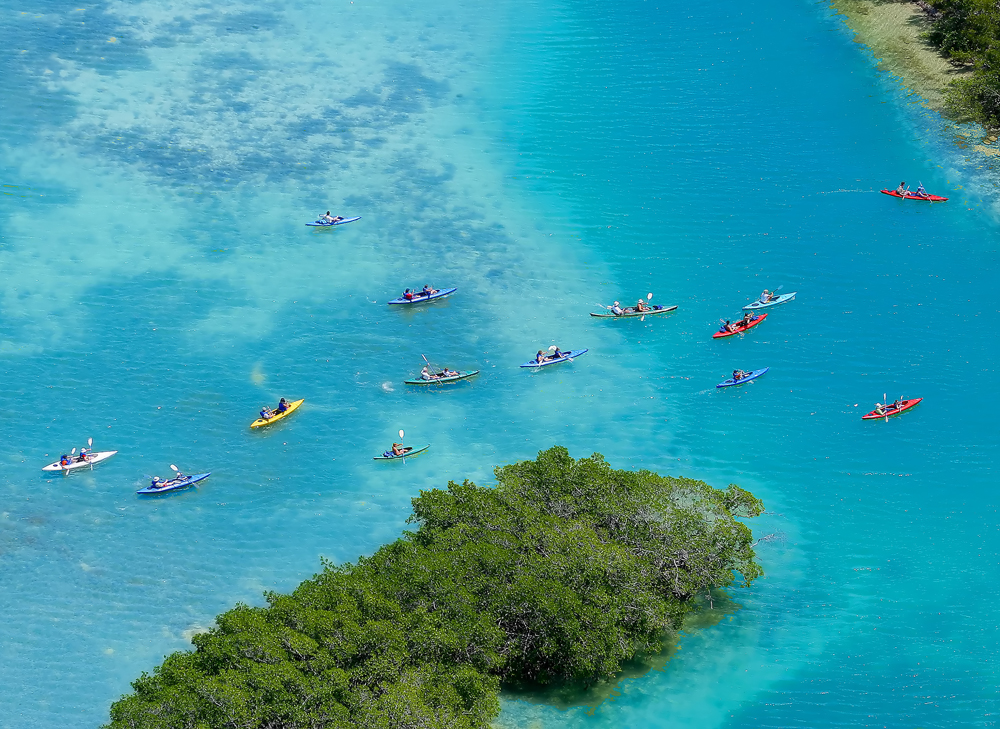After trying conch fritters and pink shrimp, browsing through some individualistic boutiques and galleries, quaffing a tall cold libation at sunset and enjoying a reef snorkeling or fishing excursion, you might figure you’ve sampled the best the Florida Keys can offer.
Guess what? You’d be wrong.

Kayakers can experience full-moon paddles, serene sunset excursions and organized volunteer cleanups in Florida Keys waters.
There’s another side of the Keys — a quiet world away from civilization, ruled by the natural ebb and flow of the ocean — that many visitors never see. It’s called the backcountry, and it’s home to one of the most diverse assortments of marine life in the world.
This shallow region of flats and mangrove islands lies mostly along the north side of the Florida Keys Overseas Highway. Not easily accessible to boat traffic, the backcountry is largely unspoiled and teeming with plant and animal life.
In part because these waters are protected within the Florida Keys National Marine Sanctuary, the tranquil region is a great place to explore nature by kayak. Shallow-draft kayaks, requiring no special skills or experience to paddle, enable just about anyone to venture into the backcountry waters.
Both guided tours and kayak rentals are available throughout the Keys, but a guided tour is usually the way to go for first-timers. Most guides are eager to share their knowledge about the region’s environment, so a tour can become a fascinating mixture of field trip, natural history lesson and just plain fun.
The Keys’ backcountry environment ranges from mangrove communities to turtle grass flats to sponge flats. Mangrove islands are composed of tangled stands of mangroves, their aerial roots forming tunnels and fantastic twisted shapes.

Kayaking along mangrove trails at Key Largo’s John Pennekamp Coral Reef State Park — the USA’s first underwater preserve — is a fascinating group activity for nature enthusiasts. (Photo by Bob Care, Florida Keys News Bureau)
Wildlife and rare birds abound; you might spot roseate spoonbills, osprey, great white herons and maybe even bald eagles. Gazing over the side of your craft, you’ll discover the rich biodiversity within the mangrove root systems (the roots are actually a nursery for young grouper, lobster, barracuda and other species).
Turtle grass areas too are a unique part of the backcountry. Turtle grass looks a lot like lawn grass — but anyone who pulls up a flat green blade is likely to see snails, tiny aquatic animals, scurrying juvenile fish and other inhabitants of this busy ecosystem.
Also a part of the backcountry are the sponge flats — the rocky sea-bottom home to bright-colored sponges and soft corals. The grass flats and sponge flats can also support small lobster, young reef fish, turtles, stingrays and big predators like shark and barracuda. If you’re lucky, you might even spot a graceful rolling tarpon.
Guided backcountry tours last from about two hours to a full day or even longer. You’ll want to bring reef-safe sunscreen, a hat or cap and a light shirt, bathing suit and towels, sunglasses, aqua shoes and a waterproof camera to capture your experiences. Many excursions include snorkeling, and snorkel gear may or may not be provided, so it’s wise to ask when making reservations.
If you love the outdoors and want to venture beyond the normal “tourist” realm, consider immersing yourself in the Florida Keys — the real, unspoiled Florida Keys — on a backcountry kayak adventure. To find one that meets your needs, check out the listings here.

